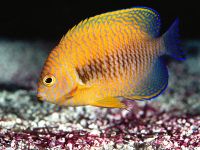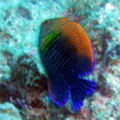Potter's Angelfish (Centropyge potteri)
From The Aquarium Wiki
Potter's Angelfish
Centropyge potteri
114 Litres (30 US G.)
10.2-12.7cm (4-5 ")
8.2 - 8.5
22.2-23.9°C (72 -75 °F)
8-12 °d
1:1 M:F
3-5 years
Family
Pomacanthidae
Contents
Additional names
- Potter's Angelfish, Russet Angelfish, Potter's Pygmy Angelfish
Additional scientific names
- Holacanthus potteri
Origin[edit]
- Eastern Central Pacific: Johnston and Hawaiian Islands.
Sexing[edit]
- These fish are not easy to sex visually and do not breed in captivity. Mature males tend to be brighter in colour than females.
Tank compatibility[edit]
- A relatively timid solitary Angelfish. Should be kept with robust yet peaceful similar-sized fish. Will nip at soft corals.
Diet[edit]
- A fish with a voracious appetite, will nibble algae around the live rock continuously. Should also accept algae-based flake and pellet food. Is known to sample most things placed in the tank. Will also accept small meaty foods, but their diets should be predominantly vegetarian.
Feeding regime[edit]
- Feed two to three times a day, and it needs to have plenty of live rock and algae to graze on. Can starve if there's not enough food.
Environment specifics[edit]
- Introduce these fish to well established set ups at least 6 months old so these fish have plenty of algae growth to graze on. Do not keep a clean sterile environment as that could result in these fish starving. The appreciate plenty of secure live rock and hiding places.
Behaviour[edit]
- An active Dwarf Angel that will spend its time grazing algae in and around live rock and rubble. When introduced to a tank it can take them a while to settle in and a good week or so to begin to accept foods.
Identification[edit]
- An attractive oval fish which is amber-orange around the head, dorsal and belly fading to indigo towards the caudal fin. It has many slender vertical blue bars down the whole body and into the fins.
Pictures[edit]
Videos[edit]
| In a shop tank with Flame Angel: |
External links[edit]
- Fishbase (Mirrors:
 )
)

